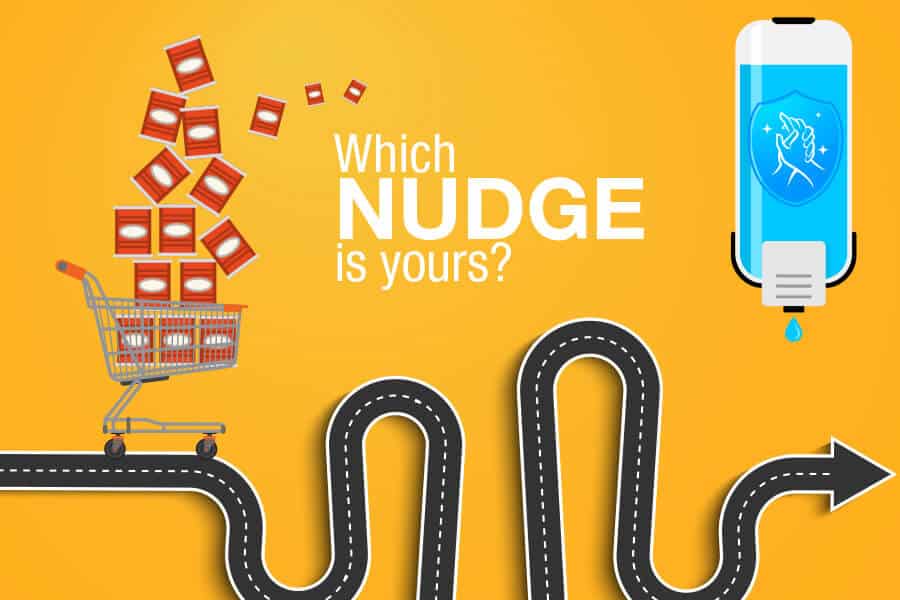Do you know how that line down the middle of the road, dividing it into equal halves so that cars will avoid hitting each other, was created? Did you know that that was a nudge? Or that the same technique is used in your local supermarket and every time you see the written message, “Hand Disinfectant”? Keep reading if you want to find out what nudges are, why and how they work, where they can be used, and much more.
How people are making decisions?
People make inconsistent decisions, because most of the time we do not have the time, the motivation, or the resources to reflect consciously on our choices. As a result, many of our decisions are the result of automatic processes and rules of thumb.
However, through a better understanding of human behavior, in both its rational and irrational dimensions, we can take more effective action to modify behavior as we wish.
Over 40 years of academic research on the decision-making process has resulted in a revolutionary theory – Behavioral Economics – one of the main messages of which, as supported by the Nobel Prize winner Daniel Kahneman, is that we are not rational beings but are rather influenced by cognitive biases and mental shortcuts, emotions, social interactions, as well as by the environment and settings where we are.
In other words, there are many subconscious processes going on in our minds every time we make a decision.
Nudges take advantage of these relatively subconscious processes and re-arrange the environment in such a way that a specific choice becomes more likely. That is why nudges have been found effective in such domains as organ donation, obesity, retirement savings, divorce, and environmental issues and healthcare.
For instance, nudges have been effectively used to improve hygiene and increase the frequency of such trivial everyday rituals as hand-washing.
However, due to its nature, originating in behavioral science, nudges can be widely used in other spheres like marketing, the concept of which will be discussed further.
One of the most straightforward reasons for marketers to be on the same wave length with the behavioral economists is the fact that if you miss the lessons from behavioral economics on what are the real drivers that influence consumers, you may end up designing a marketing effort like a campaign, which will simply not be efficient.
One of these lessons is nudges.
So What Are Nudges?
Nudge – or “non-enforced compliance” – is a technique in behavioral science, with the help of which choice architects can easily change the behavior of people without reducing the number of choices, and at a low cost. The idea of nudging was developed by legal scholar Cass Sunstein and the Nobel Prize-winning behavioral economist Richard Thaler in 2008 and presented in the book “Nudge”, where nudge is explained as the system of gentle encouragements, based on advanced knowledge of the decision-making process. That is to say, in comparison with strict regulations and laws, nudges are more liberal and lighter, leaving the right for people to choose other options, not necessarily complying with the suggested course of action.
Even though nudges are very simple, the benefit of them is a remarkable power to change behavior through cost-effective actions. For example, consider the above-mentioned line down the middle of the road, dividing it into equal halves. Just imagine for a second how hard it was to drive on a road without any of the nice signs and marks that we have nowadays. Right up until 1911, that was the reality, before Edward Hines, Wayne County Road Commissioner, came up with the idea of drawing a line down the middle of a road as a safety feature. The inspiration for such a handy idea came from seeing a leaky milk truck driving along, leaving a nice dotted line down the middle of the road. As a result, the well-known line was created, offering safer conditions for drivers. Little did they know that it was a nudge that was keeping drivers on one side of the road, stopping them from crossing the line and running the risk of ending up in an accident.

Nudges can also help, for instance, to improve ROI from marketing strategies, as it did in the case of a change which doubled the sales from the promotional offer of Campbell’s soup, without any additional cost! All that was needed was a nudge in the form of a short message placed near the product’s shelf space that said: “Limit of 12 cans per person”- a so-called anchor to consumers, which you have most probably seen repeatedly in your supermarket as well. As a result, sales of the soup rose from 3.3. to 7 cans per buyer because the message activated the idea of a good deal more than the promotional offer could have done alone.
Another example from the world of marketing can be placing a mirror near the toothpaste section or painting the isle with a reflective coding in a shop. Such actions may seem like unnecessary designs, but they will actually accomplish nudging. Passing by the toothpaste section, people will catch their reflection, including their teeth, which will increase the probability that they will want to grab some whitening toothpaste.
Nudges can be implemented through millions of other tiny things such as better lighting in some sections in a shop, leading you in that direction, or placing products on the shelves at eye level for adults or at lower levels for children for kids’ products, sales tactics that make us buy more, and other simple, effective, and low-cost techniques to encourage the adoption of new behaviors.
Criticism

However, there has been a lot of criticism related to nudges as yet another manipulation strategy or so-called social engineering. The problem of ethics is quite big in relation to nudges similarly as, for instance, with advertising in general. Assuming that progress in psychology and understanding people’s behavior continues to develop, there seems to be no limit to nudging and altering behavior as wished.
What is the solution? It can be generally assumed that as long as there is freedom of choice and a person can either choose one or another option, independently from the company’s desired outcome, there is not the issue of manipulation. Moreover, if people are nudged to do good, eat right, behave well, etc., it is alright. However, this is not a completely flawless option. Companies cannot be trusted or allowed to make such judgments themselves as this would be subjective. For this reason, the government should decide what is considered as moral and what is not.
However, arguably one of the most important aspects in fighting against manipulation by the means of nudges is the matter of the transparency of nudges. Due to the reason that nudges, however slightly, do direct people into a direction that they might not have chosen otherwise, in the case of no nudge, people should be aware of the intervention. The only problem is that nudges are claimed to be effective under the condition that people are more or less unaware of their existence and purpose. However, there is still not much information on the effect of people’s awareness of the effectiveness of nudges.
Secondly, the consequences of nudging should be considered, as very strong nudges which prevent alternative choices can be used. In such cases, people are actually subjected to techniques that directly influence their behavior without leaving a choice, which is, moreover, hidden. In these cases, if a nudge is too strong or too evident, it can easily backfire, annoying and alienating customers. Moreover, in situations like this, if consumers find out that the nudge was implemented and understand its purpose, research shows that they become immune, and the effect of the nudge will be blunted. Therefore, the result of a desired positive change in behavior can lead to a completely opposite effect. That is why it takes solid knowledge in the decision-making process and understanding of behavioral science to create really gentle encouragement rather than failed manipulations with negative outcomes.
Nudges are an amazing tool, which reportedly are being used, starting with market leaders such as Amazon, Google, Apple and many other companies you can think of, ending with your local shops, signs in the neighbourhood, or even door posters which say in red, “Do not enter”. That is why understanding their use and purpose is quite relevant in the modern, ambiguous world.
Photos: Shutterstock / Photomontage: Martina Advaney
More articles here:
Support us!
All your donations will be used to pay the magazine’s journalists and to support the ongoing costs of maintaining the site.
Share this post
Interested in co-operating with us?
We are open to co-operation from writers and businesses alike. You can reach us on our email at cooperations@youthtimemag.com/magazine@youthtimemag.com and we will get back to you as quick as we can.









